



The U.S. government this week put a $10 million bounty on a Russian man who for the past 18 years operated Try2Check, one of the cybercrime underground’s most trusted services for checking the validity of stolen credit card data. U.S. authorities say 43-year-old Denis Kulkov‘s card-checking service made him at least $18 million, which he used to buy a Ferrari, Land Rover, and other luxury items.

Denis Kulkov, a.k.a. “Nordex,” in his Ferrari. Image: USDOJ.
Launched in 2005, Try2Check soon was processing more than a million card-checking transactions per month — charging 20 cents per transaction. Cybercriminals turned to services like this after purchasing stolen credit card data from an underground shop, with an eye toward minimizing the number of cards that are inactive by the time they are put to criminal use.
Try2Check was so reliable that it eventually became the official card-checking service for some of the underground’s most bustling crime bazaars, including Vault Market, Unicc, and Joker’s Stash. Customers of these carding shops who chose to use the shop’s built-in (but a-la-carte) card checking service from Try2Check could expect automatic refunds on any cards that were found to be inactive or canceled at the time of purchase.
Many established stolen card shops will allow customers to request refunds on dead cards based on official reports from trusted third-party checking services. But in general, the bigger shops have steered customers toward using their own white-labeled version of the Try2Check service — primarily to help minimize disputes over canceled cards.
On Wednesday, May 3, Try2Check’s websites were replaced with a domain seizure notice from the U.S. Secret Service and U.S. Department of Justice, as prosecutors in the Eastern District of New York unsealed an indictment and search warrant naming Denis Gennadievich Kulkov of Samara, Russia as the proprietor.
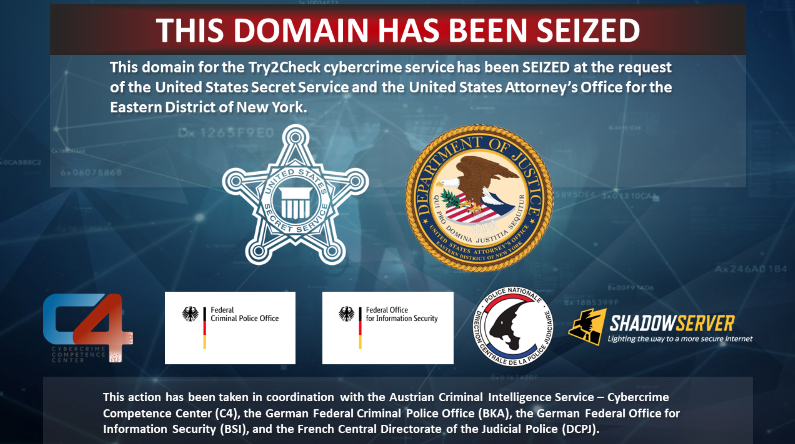
Try2Check’s login pages have been replaced with a seizure notice from U.S. law enforcement.
At the same time, the U.S. Department of State issued a $10 million reward for information leading to the arrest or conviction of Kulkov. In November 2021, the State Department began offering up to to $10 million for the name or location of any key leaders of REvil, a major Russian ransomware gang.
As noted in the Secret Service’s criminal complaint (PDF), the Try2Check service was first advertised on the closely-guarded Russian cybercrime forum Mazafaka, by someone using the handle “KreenJo.” That handle used the same ICQ instant messenger account number (555724) as a Mazafaka denizen named “Nordex.”
In February 2005, Nordex posted to Mazafaka that he was in the market for hacked bank accounts, and offered 50 percent of the take. He asked interested partners to contact him at the ICQ number 228427661 or at the email address polkas@bk.ru. As the government noted in its search warrant, Nordex exchanged messages with forum users at the time identifying himself as a then-24-year-old “Denis” from Samara, RU.
In 2017, U.S. law enforcement seized the cryptocurrency exchange BTC-e, and the Secret Service said those records show that a Denis Kulkov from Samara supplied the username “Nordexin,” email address nordexin@ya.ru, and an address in Samara.
Investigators had already found Instagram accounts where Kulkov posted pictures of his Ferrari and his family. Authorities were able to identify that Kulkov had an iCloud account tied to the address nordexin@icloud.com, and upon subpoenaing that found passport photos of Kulkov, and well as more photos of his family and pricey cars.
Like many other top cybercriminals based in Russia or in countries with favorable relations to the Kremlin, the proprietor of Try2Check was not particularly difficult to link to a real-life identity. In Kulkov’s case, it no doubt was critical to U.S. investigators that they had access to a wealth of personal information tied to a cryptocurrency exchange Kulkov had used.
However, the link between Kulkov and Try2Check can be made — ironically — based on records that have been plundered by hackers and published online over the years — including Russian email services, Russian government records, and hacked cybercrime forums.

Kulkov posing with his passport, in a photo authorities obtained by subpoenaing his iCloud account.
According to cybersecurity firm Constella Intelligence, the address polkas@bk.ru was used to register an account with the username “Nordex” at bankir[.]com, a now defunct news website that was almost standard reading for Russian speakers interested in news about various Russian financial markets.
Nordex appears to have been a finance nerd. In his early days on the forums, Nordex posted several long threads on his views about the Russian stock market and mutual fund investments.
That Bankir account was registered from the Internet address 193.27.237.66 in Samara, Russia, and included Nordex’s date of birth as April 8, 1980, as well as their ICQ number (228427661).
Cyber intelligence firm Intel 471 found that Internet address also was used to register the account “Nordex” on the Russian hacking forum Exploit back in 2006.
Constella tracked another Bankir[.]com account created from that same Internet address under the username “Polkas.” This account had the same date of birth as Nordex, but a different email address: nordia@yandex.ru. This and other “nordia@” emails shared a password: “anna59.”
Nordia@yandex.ru shares several passwords with nordia@list.ru, which Constella says was used to create an account at a religious website for an Anna Kulikova from Samara. At the Russian home furnishing store Westwing.ru, Ms. Kulikova listed her full name as Anna Vnrhoturkina Kulikova, and her address as 29 Kommunistrecheskya St., Apt. 110.
A search on that address in Constella brings up a record for an Anna Denis Vnrhoturkina Kulkov, and the phone number 879608229389.
Russian vehicle registration records have also been hacked and leaked online over the years. Those records show that Anna’s Apt 110 address is tied to a Denis Gennadyvich Kulkov, born April 8, 1980.
The vehicle Kolkov registered in 2015 at that address was a 2010 Ferrari Italia, with the license plate number K022YB190. The phone number associated with this record — 79608229389 — is exactly like Anna’s, only minus the (mis?)leading “8”. That number also is tied to a now-defunct Facebook account, and to the email addresses nordexin@ya.ru and nordexin@icloud.com.
Kulkov’s Ferrari has been photographed numerous times over the years by Russian car aficionados, including this one with the driver’s face redacted by the photographer:

The Ferrari owned by Denis Kulkov, spotted in Moscow in 2016. Image: Migalki.net.
As the title of this story suggests, the hard part for Western law enforcement isn’t identifying the Russian cybercriminals who are major players in the scene. Rather, it’s finding creative ways to capture high-value suspects if and when they do leave the protection that Russia generally extends to domestic cybercriminals within its borders who do not also harm Russian companies or consumers, or interfere with state interests.
But Russia’s war against Ukraine has caused major fault lines to appear in the cybercrime underground: Cybercriminal syndicates that previously straddled Russia and Ukraine with ease were forced to reevaluate many comrades who were suddenly working for The Other Side.
Many cybercriminals who operated with impunity from Russia and Ukraine prior to the war chose to flee those countries following the invasion, presenting international law enforcement agencies with rare opportunities to catch most-wanted cybercrooks. One of those was Mark Sokolovsky, a 26-year-old Ukrainian man who operated the popular “Raccoon” malware-as-a-service offering; Sokolovsky was apprehended in March 2022 after fleeing Ukraine’s mandatory military service orders.
Also nabbed on the lam last year was Vyacheslav “Tank” Penchukov, a senior Ukrainian member of a transnational cybercrime group that stole tens of millions of dollars over nearly a decade from countless hacked businesses. Penchukov was arrested after leaving Ukraine to meet up with his wife in Switzerland.
A sprawling online company based in Georgia that has made tens of millions of dollars purporting to sell access to jobs at the United States Postal Service (USPS) has exposed its internal IT operations and database of nearly 900,000 customers. The leaked records indicate the network’s chief technology officer in Pakistan has been hacked for the past year, and that the entire operation was created by the principals of a Tennessee-based telemarketing firm that has promoted USPS employment websites since 2016.

The website FederalJobsCenter promises to get you a job at the USPS in 30 days or your money back.
KrebsOnSecurity was recently contacted by a security researcher who said he found a huge tranche of full credit card records exposed online, and that at first glance the domain names involved appeared to be affiliated with the USPS.
Further investigation revealed a long-running international operation that has been emailing and text messaging people for years to sign up at a slew of websites that all promise they can help visitors secure employment at the USPS.
Sites like FederalJobsCenter[.]com also show up prominently in Google search results for USPS employment, and steer applicants toward making credit card “registration deposits” to ensure that one’s application for employment is reviewed. These sites also sell training, supposedly to help ace an interview with USPS human resources.
FederalJobsCenter’s website is full of content that makes it appear the site is affiliated with the USPS, although its “terms and conditions” state that it is not. Rather, the terms state that FederalJobsCenter is affiliated with an entity called US Job Services, which says it is based in Lawrenceville, Ga.
“US Job Services provides guidance, coaching, and live assistance to postal job candidates to help them perform better in each of the steps,” the website explains.
The site says applicants need to make a credit card deposit to register, and that this amount is refundable if the applicant is not offered a USPS job within 30 days after the interview process.

But a review of the public feedback on US Job Services and dozens of similar names connected to this entity over the years shows a pattern of activity: Applicants pay between $39.99 and $100 for USPS job coaching services, and receive little if anything in return. Some reported being charged the same amount monthly.
The U.S. Federal Trade Commission (FTC) has sued several times over the years to disrupt various schemes offering to help people get jobs at the Postal Service. Way back in 1998, the FTC and the USPS took action against several organizations that were selling test or interview preparation services for potential USPS employees.
“Companies promising jobs with the U.S. Postal Service are breaking federal law,” the joint USPS-FTC statement said.
In that 1998 case, the defendants behind the scheme were taking out classified ads in newspapers. Ditto for a case the FTC brought in 2005. By 2008, the USPS job exam preppers had shifted to advertising their schemes mostly online. And in 2013, the FTC won a nearly $5 million judgment against a Kentucky company purporting to offer such services.
Tim McKinlay authored a report last year at Affiliateunguru.com on whether the US Job Services website job-postal[.]com was legitimate or a scam. He concluded it was a scam based on several factors, including that the website listed multiple other names (suggesting it had recently switched names), and that he got nothing from the transaction with the job site.
“They openly admit they’re not affiliated with the US Postal Service, but claim to be experts in the field, and that, just by following the steps on their site, you easily pass the postal exams and get a job in no time,” McKinlay wrote. “But it’s really just a smoke and mirrors game. The site’s true purpose is to collect $46.95 from as many people as possible. And considering how popular this job is, they’re probably making a killing.”
KrebsOnSecurity was alerted to the data exposure by Patrick Barry, chief information officer at Charlotte, NC based Rebyc Security. Barry said he found that not only was US Job Services leaking its customer payment records in real-time and going back to 2016, but its website also leaked a log file from 2019 containing the site administrator’s contact information and credentials to the site’s back-end database.
Barry shared screenshots of that back-end database, which show the email address for the administrator of US Job Services is tab.webcoder@gmail.com. According to cyber intelligence platform Constella Intelligence, that email address is tied to the LinkedIn profile for a developer in Karachi, Pakistan named Muhammed Tabish Mirza.
A search on tab.webcoder@gmail.com at DomainTools.com reveals that email address was used to register several USPS-themed domains, including postal2017[.]com, postaljobscenter[.]com and usps-jobs[.]com.
Mr. Mirza declined to respond to questions, but the exposed database information was removed from the Internet almost immediately after KrebsOnSecurity shared the offending links.
A “Campaigns” tab on that web panel listed several advertising initiatives tied to US Job Services websites, with names like “walmart drip campaign,” “hiring activity due to virus,” “opt-in job alert SMS,” and “postal job opening.”
Another page on the US Job Services panel included a script for upselling people who call in response to email and text message solicitations, with an add-on program that normally sells for $1,200 but is being “practically given away” for a limited time, for just $49.
“There’s something else we have you can take advantage of that can help you make more money,” the script volunteers. “It’s an easy to use 12-month career development plan and program to follow that will result in you getting any job you want, not just at the post office….anywhere…and then getting promoted rapidly.”
It’s bad enough that US Job Services was leaking customer data: Constella Intelligence says the email address tied to Mr. Mirza shows up in more than a year’s worth of “bot logs” created by a malware infection from the Redline infostealer.
Constella reports that for roughly a year between 2021 and 2022, a Microsoft Windows device regularly used by Mr. Mirza and his colleagues was actively uploading all of the device’s usernames, passwords and authentication cookies to cybercriminals based in Russia.
The web-based backend for US Job Services lists more than 160 people under its “Users & Teams” tab. This page indicates that access to the consumer and payment data collected by US Job Services is currently granted to several other coders who work with Mr. Mirza in Pakistan, and to multiple executives, contractors and employees working for a call center in Murfreesboro, Tennessee.
The call center — which operates as Nextlevelsupportcenters[.]com and thenextlevelsupport[.]com — curiously has several key associates with a history of registering USPS jobs-related domain names.
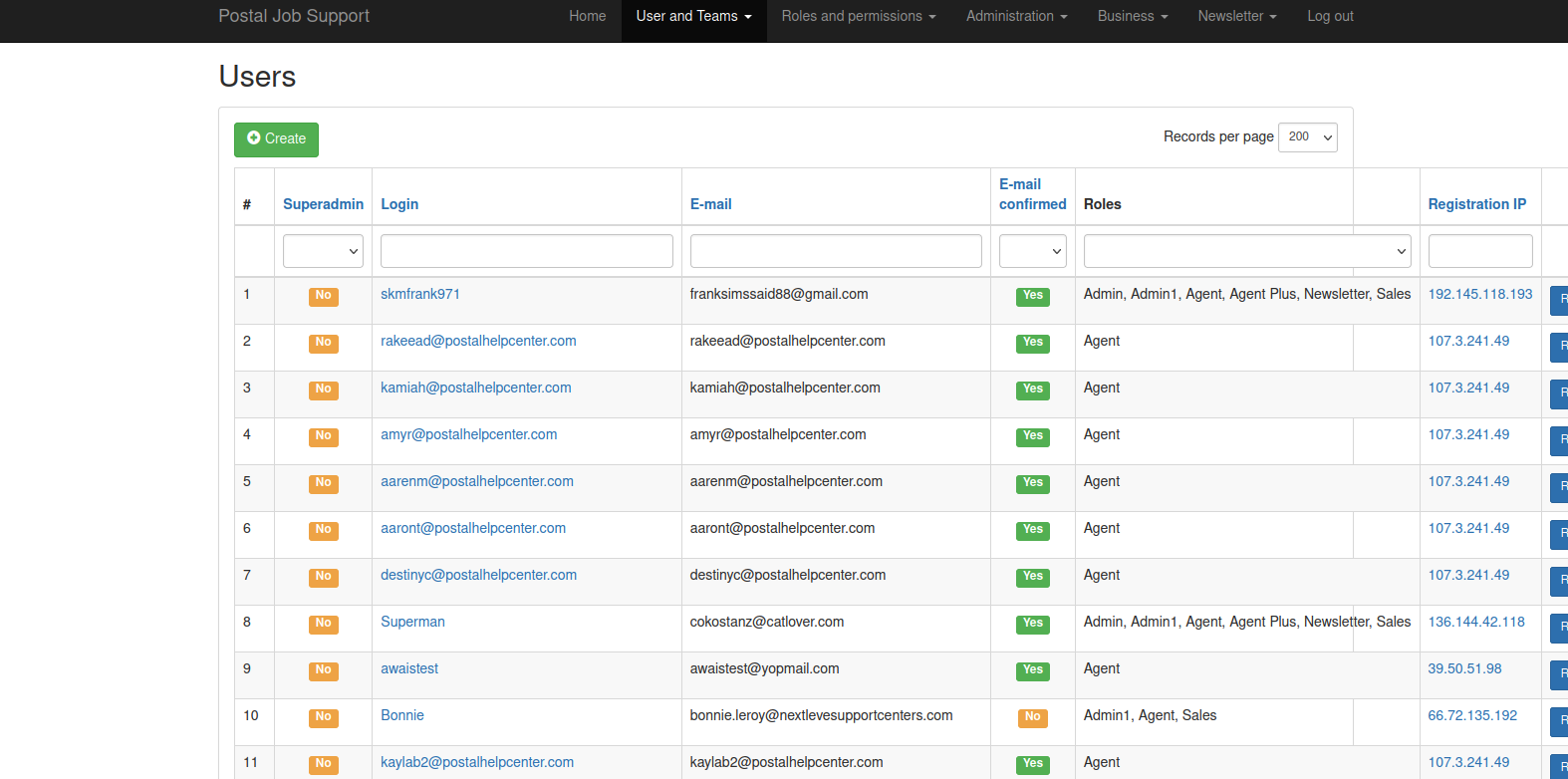
The US Job Services website has more than 160 users, including most of the employees at Next Level Support.
The website for NextLevelSupport says it was founded in 2017 by a Gary Plott, whose LinkedIn profile describes him as a seasoned telecommunications industry expert. The leaked backend database for US Job Services says Plott is a current administrator on the system, along with several other Nextlevel founders listed on the company’s site.
Reached via telephone, Plott initially said his company was merely a “white label” call center that multiple clients use to interact with customers, and that the content their call center is responsible for selling on behalf of US Job Services was not produced by NextLevelSupport.
“A few years ago, we started providing support for this postal product,” Plott said. “We didn’t develop the content but agreed we would support it.”
Interestingly, DomainTools says the Gmail address used by Plott in the US Jobs system was also used to register multiple USPS job-related domains, including postaljobssite[.]com, postalwebsite[.]com, usps-nlf[.]com, usps-nla[.]com.
Asked to reconcile this with his previous statement, Plott said he never did anything with those sites but acknowledged that his company did decide to focus on the US Postal jobs market from the very beginning.
Plott said his company never refuses to issue a money-back request from a customer, because doing so would result in costly chargebacks for NextLevel (and presumably for the many credit card merchant accounts apparently set up by Mr. Mirza).
“We’ve never been deceptive,” Plott said, noting that customers of the US Job Services product receive a digital download with tips on how to handle a USPS interview, as well as unlimited free telephone support if they need it.
“We’ve never told anyone we were the US Postal Service,” Plott continued. “We make sure people fully understand that they are not required to buy this product, but we think we can help you and we have testimonials from people we have helped. But ultimately you as the customer make that decision.”
An email address in the US Job Services teams page for another user — Stephanie Dayton — was used to register the domains postalhiringreview[.]com, and postalhiringreviewboard[.]org back in 2014. Reached for comment, Ms. Dayton said she has provided assistance to Next Level Support Centers with their training and advertising, but never in the capacity as an employee.
Perhaps the most central NextLevel associate who had access to US Job Services was Russell Ramage, a telemarketer from Warner Robins, Georgia. Ramage is listed in South Carolina incorporation records as the owner of a now-defunct call center service called Smart Logistics, a company whose name appears in the website registration records for several early and long-running US Job Services sites.

According to the state of Georgia, Russell Ramage was the registered agent of several USPS job-themed companies.
The leaked records show the email address used by Ramage also registered multiple USPS jobs-related domains, including postalhiringcenter[.]com, postalhiringreviews[.]com, postaljobs-email[.]com, and postaljobssupport1[.]com.
A review of business incorporation records in Georgia indicate Ramage was the registered agent for at least three USPS-related companies over the years, including Postal Career Placement LLC, Postal Job Services Inc., and Postal Operations Inc. All three companies were founded in 2015, and are now dissolved.
An obituary dated February 2023 says Russell Ramage recently passed away at the age of 41. No cause of death was stated, but the obituary goes on to say that Russ “Rusty” Ramage was “preceded in death by his mother, Anita Lord Ramage, pets, Raine and Nola and close friends, Nicole Reeves and Ryan Rawls.”
In 2014, then 33-year-old Ryan “Jootgater” Rawls of Alpharetta, Georgia pleaded guilty to conspiring to distribute controlled substances. Rawls also grew up in Warner Robins, and was one of eight suspects charged with operating a secret darknet narcotics ring called the Farmer’s Market, which federal prosecutors said trafficked in millions of dollars worth of controlled substances.
Reuters reported that an eighth suspect in that case had died by the time of Rawls’ 2014 guilty plea, although prosecutors declined to offer further details about that. According to his obituary, Ryan Christopher Rawls died at the age of 38 on Jan. 28, 2019.
In a comment on Ramage’s memorial wall, Stephanie Dayton said she began working with Ramage in 2006.
“Our friendship far surpassed a working one, we had a very close bond and became like brother and sister,” Dayton wrote. “I loved Russ deeply and he was like family. He was truly one of the best human beings I have ever known. He was kind and sweet and truly cared about others. Never met anyone like him. He will be truly missed. RIP brother.”
The FTC and USPS note that while applicants for many entry-level postal jobs are required to take a free postal exam, the tests are usually offered only every few years in any particular district, and there are no job placement guarantees based on score.
“If applicants pass the test by scoring at least 70 out of 100, they are placed on a register, ranked by their score,” the FTC explained. “When a position becomes open, the local post office looks to the applicable register for that geographic location and calls the top three applicants. The score is only one of many criteria taken into account for employment. The exams test general aptitude, something that cannot necessarily be increased by studying.”
The FTC says anyone interested in a job at the USPS should inquire at their local postal office, where applicants generally receive a free packet of information about required exams. More information about job opportunities at the postal service is available at the USPS’s careers website.
Michael Martel, spokesperson for the United States Postal Inspection Service, said in a written statement that the USPS has no affiliation with the websites or companies named in this story.
“To learn more about employment with USPS, visit USPS.com/careers,” Martel wrote. “If you are the victim of a crime online report it to the FBI’s Internet Crime Complaint Center (IC3) at www.ic3.gov. To report fraud committed through or toward the USPS, its employees, or customers, report it to the United States Postal Inspection Service (USPIS) at www.uspis.gov/report.”
According to the leaked back-end server for US Job Services, here is a list of the current sites selling this product:
usjobshelpcenter[.]com
usjobhelpcenter[.]com
job-postal[.]com
localpostalhiring[.]com
uspostalrecruitment[.]com
postalworkerjob[.]com
next-level-now[.]com
postalhiringcenters[.]com
postofficehiring[.]com
postaljobsplacement[.]com
postal-placement[.]com
postofficejobopenings[.]com
postalexamprep[.]com
postaljobssite[.]com
postalwebsite[.]com
postalcareerscenters[.]com
postal-hiring[.]com
postal-careers[.]com
postal-guide[.]com
postal-hiring-guide[.]com
postal-openings[.]com
postal-placement[.]com
postofficeplacements[.]com
postalplacementservices[.]com
postaljobs20[.]com
postal-jobs-placement[.]com
postaljobopenings[.]com
postalemployment[.]com
postaljobcenters[.]com
postalmilitarycareers[.]com
epostaljobs[.]com
postal-job-center[.]com
postalcareercenter[.]com
postalhiringcenters[.]com
postal-job-center[.]com
postalcareercenter[.]com
postalexamprep[.]com
postalplacementcenters[.]com
postalplacementservice[.]com
postalemploymentservices[.]com
uspostalhiring[.]com
We learned some remarkable new details this week about the recent supply-chain attack on VoIP software provider 3CX. The lengthy, complex intrusion has all the makings of a cyberpunk spy novel: North Korean hackers using legions of fake executive accounts on LinkedIn to lure people into opening malware disguised as a job offer; malware targeting Mac and Linux users working at defense and cryptocurrency firms; and software supply-chain attacks nested within earlier supply chain attacks.
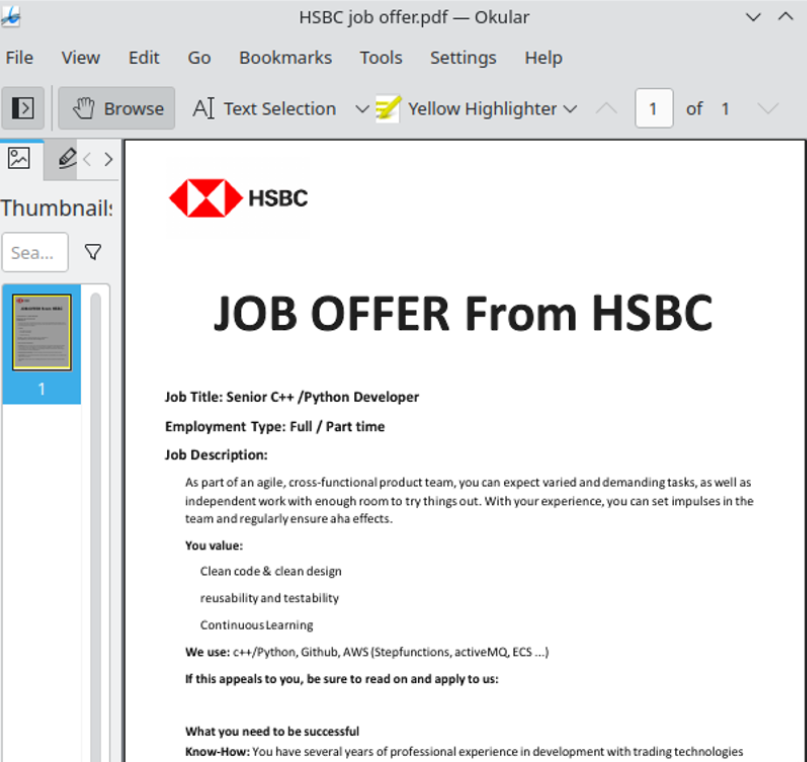
Researchers at ESET say this job offer from a phony HSBC recruiter on LinkedIn was North Korean malware masquerading as a PDF file.
In late March 2023, 3CX disclosed that its desktop applications for both Windows and macOS were compromised with malicious code that gave attackers the ability to download and run code on all machines where the app was installed. 3CX says it has more than 600,000 customers and 12 million users in a broad range of industries, including aerospace, healthcare and hospitality.
3CX hired incident response firm Mandiant, which released a report on Wednesday that said the compromise began in 2022 when a 3CX employee installed a malware-laced software package distributed via an earlier software supply chain compromise that began with a tampered installer for X_TRADER, a software package provided by Trading Technologies.
“This is the first time Mandiant has seen a software supply chain attack lead to another software supply chain attack,” reads the April 20 Mandiant report.
Mandiant found the earliest evidence of compromise uncovered within 3CX’s network was through the VPN using the employee’s corporate credentials, two days after the employee’s personal computer was compromised.
“Eventually, the threat actor was able to compromise both the Windows and macOS build environments,” 3CX said in an April 20 update on their blog.
Mandiant concluded that the 3CX attack was orchestrated by the North Korean state-sponsored hacking group known as Lazarus, a determination that was independently reached earlier by researchers at Kaspersky Lab and Elastic Security.
Mandiant found the compromised 3CX software would download malware that sought out new instructions by consulting encrypted icon files hosted on GitHub. The decrypted icon files revealed the location of the malware’s control server, which was then queried for a third stage of the malware compromise — a password stealing program dubbed ICONICSTEALER.
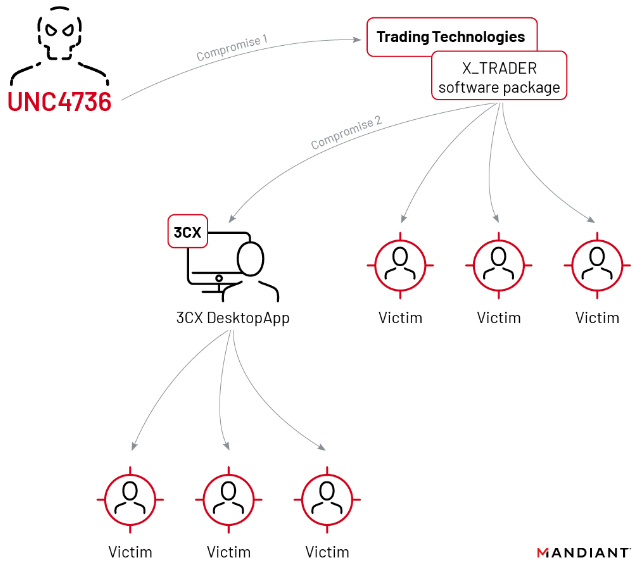
The double supply chain compromise that led to malware being pushed out to some 3CX customers. Image: Mandiant.
Meanwhile, the security firm ESET today published research showing remarkable similarities between the malware used in the 3CX supply chain attack and Linux-based malware that was recently deployed via fake job offers from phony executive profiles on LinkedIn. The researchers said this was the first time Lazarus had been spotted deploying malware aimed at Linux users.
As reported in a series last summer here, LinkedIn has been inundated this past year by fake executive profiles for people supposedly employed at a range of technology, defense, energy and financial companies. In many cases, the phony profiles spoofed chief information security officers at major corporations, and some attracted quite a few connections before their accounts were terminated.
Mandiant, Proofpoint and other experts say Lazarus has long used these bogus LinkedIn profiles to lure targets into opening a malware-laced document that is often disguised as a job offer. This ongoing North Korean espionage campaign using LinkedIn was first documented in August 2020 by ClearSky Security, which said the Lazarus group operates dozens of researchers and intelligence personnel to maintain the campaign globally.
Microsoft Corp., which owns LinkedIn, said in September 2022 that it had detected a wide range of social engineering campaigns using a proliferation of phony LinkedIn accounts. Microsoft said the accounts were used to impersonate recruiters at technology, defense and media companies, and to entice people into opening a malicious file. Microsoft found the attackers often disguised their malware as legitimate open-source software like Sumatra PDF and the SSH client Putty.
Microsoft attributed those attacks to North Korea’s Lazarus hacking group, although they’ve traditionally referred to this group as “ZINC“. That is, until earlier this month, when Redmond completely revamped the way it names threat groups; Microsoft now references ZINC as “Diamond Sleet.”
The ESET researchers said they found a new fake job lure tied to an ongoing Lazarus campaign on LinkedIn designed to compromise Linux operating systems. The malware was found inside of a document that offered an employment contract at the multinational bank HSBC.
“A few weeks ago, a native Linux payload was found on VirusTotal with an HSBC-themed PDF lure,” wrote ESET researchers Peter Kalnai and Marc-Etienne M.Leveille. “This completes Lazarus’s ability to target all major desktop operating systems. In this case, we were able to reconstruct the full chain, from the ZIP file that delivers a fake HSBC job offer as a decoy, up until the final payload.”
ESET said the malicious PDF file used in the scheme appeared to have a file extension of “.pdf,” but that this was a ruse. ESET discovered that the dot in the filename wasn’t a normal period but instead a Unicode character (U+2024) representing a “leader dot,” which is often used in tables of contents to connect section headings with the page numbers on which those sections begin.
“The use of the leader dot in the filename was probably an attempt to trick the file manager into treating the file as an executable instead of a PDF,” the researchers continued. “This could cause the file to run when double-clicked instead of opening it with a PDF viewer.”
ESET said anyone who opened the file would see a decoy PDF with a job offer from HSBC, but in the background the executable file would download additional malware payloads. The ESET team also found the malware was able to manipulate the program icon displayed by the malicious PDF, possibly because fiddling with the file extension could cause the user’s system to display a blank icon for the malware lure.
Kim Zetter, a veteran Wired.com reporter and now independent security journalist, interviewed Mandiant researchers who said they expect “many more victims” will be discovered among the customers of Trading Technologies and 3CX now that news of the compromised software programs is public.
“Mandiant informed Trading Technologies on April 11 that its X_Trader software had been compromised, but the software maker says it has not had time to investigate and verify Mandiant’s assertions,” Zetter wrote in her Zero Day newsletter on Substack. For now, it remains unclear whether the compromised X_Trader software was downloaded by people at other software firms.
If there’s a silver lining here, the X_Trader software had been decommissioned in April 2020 — two years before the hackers allegedly embedded malware in it.
“The company hadn’t released new versions of the software since that time and had stopped providing support for the product, making it a less-than-ideal vector for the North Korean hackers to infect customers,” Zetter wrote.

KrebsOnSecurity received a nice bump in traffic this week thanks to tweets from the Federal Bureau of Investigation (FBI) and the Federal Communications Commission (FCC) about “juice jacking,” a term first coined here in 2011 to describe a potential threat of data theft when one plugs their mobile device into a public charging kiosk. It remains unclear what may have prompted the alerts, but the good news is that there are some fairly basic things you can do to avoid having to worry about juice jacking.
On April 6, 2023, the FBI’s Denver office issued a warning about juice jacking in a tweet.
“Avoid using free charging stations in airports, hotels or shopping centers,” the FBI’s Denver office warned. “Bad actors have figured out ways to use public USB ports to introduce malware and monitoring software onto devices. Carry your own charger and USB cord and use an electrical outlet instead.”
Five days later, the Federal Communications Commission (FCC) issued a similar warning. “Think twice before using public charging stations,” the FCC tweeted. “Hackers could be waiting to gain access to your personal information by installing malware and monitoring software to your devices. This scam is referred to as juice jacking.”
The FCC tweet also provided a link to the agency’s awareness page on juice jacking, which was originally published in advance of the Thanksgiving Holiday in 2019 but was updated in 2021 and then again shortly after the FBI’s tweet was picked up by the news media. The alerts were so broadly and breathlessly covered in the press that a mention of juice jacking even made it into this week’s Late Late Show with James Corden.
The term juice jacking crept into the collective paranoia of gadget geeks in the summer of 2011, thanks to the headline for a story here about researchers at the DEFCON hacker convention in Vegas who’d set up a mobile charging station designed to educate the unwary to the reality that many mobile devices connected to a computer would sync their data by default.
Since then, Apple, Google and other mobile device makers have changed the way their hardware and software works so that their devices no longer automatically sync data when one plugs them into a computer with a USB charging cable. Instead, users are presented with a prompt asking if they wish to trust a connected computer before any data transfer can take place.
On the other hand, the technology needed to conduct a sneaky juice jacking attack has become far more miniaturized, accessible and cheap. And there are now several products anyone can buy that are custom-built to enable juice jacking attacks.
Probably the best known example is the OMG cable, a $180 hacking device made for professional penetration testers that looks more or less like an Apple or generic USB charging cable. But inside the OMG cable is a tiny memory chip and a Wi-Fi transmitter that creates a Wi-Fi hotspot, to which the attacker can remotely connect using a smartphone app and run commands on the device.
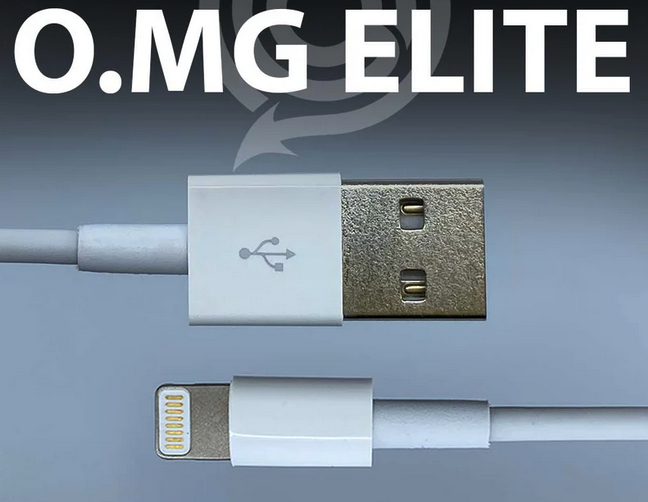
The $180 “OMG cable.” Image: hak5.org.
Brian Markus is co-founder of Aries Security, and one of the researchers who originally showcased the threat from juice jacking at the 2011 DEFCON. Markus said he isn’t aware of any public accounts of juice jacking kiosks being found in the wild, and said he’s unsure what prompted the recent FBI alert.
But Markus said juice jacking is still a risk because it is far easier and cheaper these days for would-be attackers to source and build the necessary equipment.
“Since then, the technology and components have become much smaller and very easy to build, which puts this in the hands of less sophisticated threat actors,” Markus said. “Also, you can now buy all this stuff over the counter. I think the risk is possibly higher now than it was a decade ago, because a much larger population of people can now pull this off easily.”
How seriously should we take the recent FBI warning? An investigation by the myth-busting site Snopes suggests the FBI tweet was just a public service announcement based on a dated advisory. Snopes reached out to both the FBI and the FCC to request data about how widespread the threat of juice jacking is in 2023.
“The FBI replied that its tweet was a ‘standard PSA-type post’ that stemmed from the FCC warning,” Snopes reported. “An FCC spokesperson told Snopes that the commission wanted to make sure that their advisory on “juice-jacking,” first issued in 2019 and later updated in 2021, was up-to-date so as to ensure ‘the consumers have the most up-to-date information.’ The official, who requested anonymity, added that they had not seen any rise in instances of consumer complaints about juice-jacking.”
What can you do to avoid juice jacking? Bring your own gear. A general rule of thumb in security is that if an adversary has physical access to your device, you can no longer trust the security or integrity of that device. This also goes for things that plug into your devices.
Juice jacking isn’t possible if a device is charged via a trusted AC adapter, battery backup device, or through a USB cable with only power wires and no data wires present. If you lack these things in a bind and still need to use a public charging kiosk or random computer, at least power your device off before plugging it in.
John Clifton Davies, a 60-year-old con man from the United Kingdom who fled the country in 2015 before being sentenced to 12 years in prison for fraud, has enjoyed a successful life abroad swindling technology startups by pretending to be a billionaire investor. Davies’ newest invention appears to be “CodesToYou,” which purports to be a “full cycle software development company” based in the U.K.

The scam artist John Bernard a.k.a. Alan John Mykailov (left) in a recent Zoom call, and a mugshot of John Clifton Davies from nearly a decade earlier.
Several articles here have delved into the history of John Bernard, the pseudonym used by a fake billionaire technology investor who tricked dozens of startups into giving him tens of millions of dollars.
John Bernard’s real name is John Clifton Davies, a convicted fraudster from the United Kingdom who is currently a fugitive from justice. For several years until reinventing himself again quite recently, Bernard pretended to be a billionaire Swiss investor who made his fortunes in the dot-com boom 20 years ago.
“The Private Office of John Bernard” let it be known to investment brokers that he had tens of millions of dollars to invest in tech startups, and he attracted a stream of new victims by offering extraordinarily generous finder’s fees to brokers who helped him secure new clients. But those brokers would eventually get stiffed because Bernard’s company would never consummate a deal.

John Bernard’s former website, where he pretended to be a billionaire tech investor.
Bernard would promise to invest millions in tech startups, and then insist that companies pay tens of thousands of dollars worth of due diligence fees up front. However, the due diligence company he insisted on using — another Swiss firm called The Inside Knowledge GmbH — also was secretly owned by Bernard, who would invariably pull out of the deal after receiving the due diligence money.
A variety of clues suggest Davies has recently adopted at least one other identity — Alan John Mykhailov — who is listed as chairman of a British concern called CodesToYou LTD, incorporated in May 2022. The CodesToYou website says the company employs talented coders in several countries, and that its programmers offer “your ultimate balance between speed, cost and quality.”

The team from CodesToYou.
In response to questions from KrebsOnSecurity, CodesToYou’s marketing manager — who gave their name only as “Zhena” — said the company was not affiliated with any John Bernard or John Clifton Davies, and maintained that CodesToYou is a legitimate enterprise.
But publicly available information about this company and its leadership suggests otherwise. Official incorporation documents from the U.K.’s Companies House represent that CodesToYou is headed by an Alan John Mykhailov, a British citizen born in March 1958.
Companies House says Mykhailov is an officer in three other companies, including one called Blackstone Corporate Alliance Ltd. According to the Swiss business tracking service business-monitor.ch, Blackstone Corporate Alliance Ltd. is currently the entity holding a decision-making role in John Bernard’s fake due diligence company — The Inside Knowledge GmbH — which is now in liquidation.

A screen shot of the stock photos and corporate-speak on John Bernard’s old website. Image: Archive.org
Also listed as a partner in Blackstone Corporate Alliance Limited is Igor Hubskyi (a.k.a. Igor Gubskyi), a Ukrainian man who was previously president of The Inside Knowledge GmbH.
The CodesToYou website says the company’s marketing team lead is Maria Yakovleva, and the photo of this employee matches the profile for the LinkedIn account name “Maria Y.” That same LinkedIn profile and photo previously listed Maria by a different first and last name — Mariya Kulikova; back then, Ms. Kulikova’s LinkedIn profile said she was an executive assistant in The Private Office of Mr. John Bernard.
Companies House lists Alan John Mykhailov as a current officer in two other companies, including Frisor Limited, and Ardelis Solutions Limited. A cached copy of the now-defunct Ardelis Solutions website says it was a private equity firm.
CodesToYou’s Maria also included Ardelis Solutions in the work history section of her LinkedIn resume. That is, until being contacted by this author on LinkedIn, after which Maria’s profile picture and any mention of Ardelis Solutions were deleted.
Listed as head of business development at CodesToYou is David Bruno, a Canadian man whose LinkedIn profile says he is founder of an organization called “World Privacy Resource.” As KrebsOnSecurity reported in 2020, Bruno was at the time promoting himself as the co-CEO of a company called SafeSwiss Secure Communication AG, and the founder of another tech startup called Secure Swiss Data.
Secure Swiss Data’s domain — secureswissdata.com — is a Swiss concern that sells encrypted email and data services. According to DomainTools.com, that website name was registered in 2015 by The Inside Knowledge GmbH. In February 2020, a press release announced that Secure Swiss Data was purchased in an “undisclosed multimillion buyout” by SafeSwiss Secure Communication AG.

A cached copy of the Ardelis Solutions website, which said it was a private equity firm and included similar stock images as John Bernard’s investment website.
When reached in 2020 and asked about his relationship to Mr. Bernard, Mr. Bruno said the two were business partners and that he couldn’t imagine that Mr. Bernard would be involved in anything improper. To this day Mr. Bruno is the only person I’ve spoken to who has had anything positive to say about Mr. Bernard.
Mr. Bruno did not respond to requests for comment this time around, but his LinkedIn profile no longer makes any mention of Secure Swiss Data or SafeSwiss — both companies he claimed to run for many years. Nor does it mention CodesToYou. However, Mr. Bruno’s former company SafeSwiss is listed as one of the six “portfolio” companies whose services are promoted on the CodesToYou website.
In mid-2021, Bruno announced he was running for public office in Ontario.
“The Kenora resident is no stranger to the government as he contributed to Canada’s new Digital Charter, Bill C-11, which is a new Cyber Security policy,” reported Drydennow.com, a news website that covers Northwestern Ontario. Drydennow says the next federal election is expected to be held on or before Oct. 16, 2023.
John Clifton Davies was convicted in 2015 of swindling businesses throughout the U.K. that were struggling financially and seeking to restructure their debt. For roughly six years, Davies ran a series of firms that pretended to offer insolvency services, but instead simply siphoned what little remaining money these companies had.
The very first entity mentioned in the technology portfolio advertised on the CodesToYou website is called “MySolve,” and it purports to offer a “multi-feature platform for insolvency practitioners.”
Mr. Davies’ fourth wife, Iryna Davies, is listed as a director of one of the insolvency consulting businesses in the U.K. that was part of John Davies’ 2015 fraud conviction. Prior to his trial for fraud, Davies served 16 months in jail before being cleared of murdering his third wife on their honeymoon in India: Colette Davies, 39, died after falling 80 feet from a viewing point at a steep gorge in the Himachal Pradesh region of India.
Mr. Davies was charged with murder and fraud after he attempted to collect GBP 132,000 in her life insurance payout, but British prosecutors ultimately conceded they did not have enough evidence to convict him.
The scams favored by Davies and his alter egos are smart because he never approaches investors directly; rather, investors are incentivized to put his portfolio in front of tech firms seeking financial backing. And all the best cons begin as an idea or possibility planted in the target’s mind.
It’s also a reliable scam because companies bilked by small-time investment schemes rarely pursue legal action, mainly because the legal fees involved can quickly surpass the losses. On top of that, many victims will likely be too ashamed to admit their duping. Victims who do press their case in court and win then face the daunting challenge of collecting damages from a slew of ephemeral shell corporations.
The latest Bernard victim to speak publicly — a Norwegian company hoping to build a fleet of environmentally friendly shipping vessels — is now embroiled in a lawsuit over a deal gone bad. As part of that scam, Bernard falsely claimed to have secured $100 million from six other wealthy investors, including the founder of Uber and the artist Abel Makkonen Tesfaye, better known as The Weeknd.
If you liked this story, check out my previous reporting on John Bernard/Davies:
Due Diligence That Money Can’t Buy
Who is Tech Investor John Bernard?
Promising Infusions of Cash, Fake Investor John Bernard Walked Away With $30 Million
Investment Scammer John Davies Reinvents Himself?
Fake Investor John Bernard Sinks Norwegian Green Shipping Dreams




A new breach involving data from nine million AT&T customers is a fresh reminder that your mobile provider likely collects and shares a great deal of information about where you go and what you do with your mobile device — unless and until you affirmatively opt out of this data collection. Here’s a primer on why you might want to do that, and how.

Image: Shutterstock
Telecommunications giant AT&T disclosed this month that a breach at a marketing vendor exposed certain account information for nine million customers. AT&T said the data exposed did not include sensitive information, such as credit card or Social Security numbers, or account passwords, but was limited to “Customer Proprietary Network Information” (CPNI), such as the number of lines on an account.
Certain questions may be coming to mind right now, like “What the heck is CPNI?” And, ‘If it’s so ‘customer proprietary,’ why is AT&T sharing it with marketers?” Also maybe, “What can I do about it?” Read on for answers to all three questions.
AT&T’s disclosure said the information exposed included customer first name, wireless account number, wireless phone number and email address. In addition, a small percentage of customer records also exposed the rate plan name, past due amounts, monthly payment amounts and minutes used.
CPNI refers to customer-specific “metadata” about the account and account usage, and may include:
-Called phone numbers
-Time of calls
-Length of calls
-Cost and billing of calls
-Service features
-Premium services, such as directory call assistance
According to a succinct CPNI explainer at TechTarget, CPNI is private and protected information that cannot be used for advertising or marketing directly.
“An individual’s CPNI can be shared with other telecommunications providers for network operating reasons,” wrote TechTarget’s Gavin Wright. “So, when the individual first signs up for phone service, this information is automatically shared by the phone provider to partner companies.”
Is your mobile Internet usage covered by CPNI laws? That’s less clear, as the CPNI rules were established before mobile phones and wireless Internet access were common. TechTarget’s CPNI primer explains:
“Under current U.S. law, cellphone use is only protected as CPNI when it is being used as a telephone. During this time, the company is acting as a telecommunications provider requiring CPNI rules. Internet use, websites visited, search history or apps used are not protected CPNI because the company is acting as an information services provider not subject to these laws.”
Hence, the carriers can share and sell this data because they’re not explicitly prohibited from doing so. All three major carriers say they take steps to anonymize the customer data they share, but researchers have shown it is not terribly difficult to de-anonymize supposedly anonymous web-browsing data.
“Your phone, and consequently your mobile provider, know a lot about you,” wrote Jack Morse for Mashable. “The places you go, apps you use, and the websites you visit potentially reveal all kinds of private information — e.g. religious beliefs, health conditions, travel plans, income level, and specific tastes in pornography. This should bother you.”
Happily, all of the U.S. carriers are required to offer customers ways to opt out of having data about how they use their devices shared with marketers. Here’s a look at some of the carrier-specific practices and opt-out options.
AT&T’s policy says it shares device or “ad ID”, combined with demographics including age range, gender, and ZIP code information with third parties which explicitly include advertisers, programmers, and networks, social media networks, analytics firms, ad networks and other similar companies that are involved in creating and delivering advertisements.
AT&T said the data exposed on 9 million customers was several years old, and mostly related to device upgrade eligibility. This may sound like the data went to just one of its partners who experienced a breach, but in all likelihood it also went to hundreds of AT&T’s partners.
AT&T’s CPNI opt-out page says it shares CPNI data with several of its affiliates, including WarnerMedia, DirecTV and Cricket Wireless. Until recently, AT&T also shared CPNI data with Xandr, whose privacy policy in turn explains that it shares data with hundreds of other advertising firms. Microsoft bought Xandr from AT&T last year.
According to the Electronic Privacy Information Center (EPIC), T-Mobile seems to be the only company out of the big three to extend to all customers the rights conferred by the California Consumer Privacy Act (CCPA).
EPIC says T-Mobile customer data sold to third parties uses another unique identifier called mobile advertising IDs or “MAIDs.” T-Mobile claims that MAIDs don’t directly identify consumers, but under the CCPA MAIDs are considered “personal information” that can be connected to IP addresses, mobile apps installed or used with the device, any video or content viewing information, and device activity and attributes.
T-Mobile customers can opt out by logging into their account and navigating to the profile page, then to “Privacy and Notifications.” From there, toggle off the options for “Use my data for analytics and reporting” and “Use my data to make ads more relevant to me.”
Verizon’s privacy policy says it does not sell information that personally identities customers (e.g., name, telephone number or email address), but it does allow third-party advertising companies to collect information about activity on Verizon websites and in Verizon apps, through MAIDs, pixels, web beacons and social network plugins.
According to Wired.com’s tutorial, Verizon users can opt out by logging into their Verizon account through a web browser or the My Verizon mobile app. From there, select the Account tab, then click Account Settings and Privacy Settings on the web. For the mobile app, click the gear icon in the upper right corner and then Manage Privacy Settings.
On the privacy preferences page, web users can choose “Don’t use” under the Custom Experience section. On the My Verizon app, toggle any green sliders to the left.
EPIC notes that all three major carriers say resetting the consumer’s device ID and/or clearing cookies in the browser will similarly reset any opt-out preferences (i.e., the customer will need to opt out again), and that blocking cookies by default may also block the opt-out cookie from being set.
T-Mobile says its opt out is device-specific and/or browser-specific. “In most cases, your opt-out choice will apply only to the specific device or browser on which it was made. You may need to separately opt out from your other devices and browsers.”
Both AT&T and Verizon offer opt-in programs that gather and share far more information, including device location, the phone numbers you call, and which sites you visit using your mobile and/or home Internet connection. AT&T calls this their Enhanced Relevant Advertising Program; Verizon’s is called Custom Experience Plus.
In 2021, multiple media outlets reported that some Verizon customers were being automatically enrolled in Custom Experience Plus — even after those customers had already opted out of the same program under its previous name — “Verizon Selects.”
If none of the above opt out options work for you, at a minimum you should be able to opt out of CPNI sharing by calling your carrier, or by visiting one of their stores.
Why should you opt out of sharing CPNI data? For starters, some of the nation’s largest wireless carriers don’t have a great track record in terms of protecting the sensitive information that you give them solely for the purposes of becoming a customer — let alone the information they collect about your use of their services after that point.
In January 2023, T-Mobile disclosed that someone stole data on 37 million customer accounts, including customer name, billing address, email, phone number, date of birth, T-Mobile account number and plan details. In August 2021, T-Mobile acknowledged that hackers made off with the names, dates of birth, Social Security numbers and driver’s license/ID information on more than 40 million current, former or prospective customers who applied for credit with the company.
Last summer, a cybercriminal began selling the names, email addresses, phone numbers, SSNs and dates of birth on 23 million Americans. An exhaustive analysis of the data strongly suggested it all belonged to customers of one AT&T company or another. AT&T stopped short of saying the data wasn’t theirs, but said the records did not appear to have come from its systems and may be tied to a previous data incident at another company.
However frequently the carriers may alert consumers about CPNI breaches, it’s probably nowhere near often enough. Currently, the carriers are required to report a consumer CPNI breach only in cases “when a person, without authorization or exceeding authorization, has intentionally gained access to, used or disclosed CPNI.”
But that definition of breach was crafted eons ago, back when the primary way CPNI was exposed was through “pretexting,” such when the phone company’s employees are tricked into giving away protected customer data.
In January, regulators at the U.S. Federal Communications Commission (FCC) proposed amending the definition of “breach” to include things like inadvertent disclosure — such as when companies expose CPNI data on a poorly-secured server in the cloud. The FCC is accepting public comments on the matter until March 24, 2023.
While it’s true that the leak of CPNI data does not involve sensitive information like Social Security or credit card numbers, one thing AT&T’s breach notice doesn’t mention is that CPNI data — such as balances and payments made — can be abused by fraudsters to make scam emails and text messages more believable when they’re trying to impersonate AT&T and phish AT&T customers.
The other problem with letting companies share or sell your CPNI data is that the wireless carriers can change their privacy policies at any time, and you are assumed to be okay with those changes as long as you keep using their services.
For example, location data from your wireless device is most definitely CPNI, and yet until very recently all of the major carriers sold their customers’ real-time location data to third party data brokers without customer consent.
What was their punishment? In 2020, the FCC proposed fines totaling $208 million against all of the major carriers for selling their customers’ real-time location data. If that sounds like a lot of money, consider that all of the major wireless providers reported tens of billions of dollars in revenue last year (e.g., Verizon’s consumer revenue alone was more than $100 billion last year).
If the United States had federal privacy laws that were at all consumer-friendly and relevant to today’s digital economy, this kind of data collection and sharing would always be opt-in by default. In such a world, the enormously profitable wireless industry would likely be forced to offer clear financial incentives to customers who choose to share this information.
But until that day arrives, understand that the carriers can change their data collection and sharing policies when it suits them. And regardless of whether you actually read any notices about changes to their privacy policies, you will have agreed to those changes as long as you continue using their service.

Today, we released the latest issue of The Domain Name Industry Brief, which shows that the fourth quarter of 2022 closed with 350.4 million domain name registrations across all top-level domains (TLDs), an increase of 0.5 million domain name registrations, or 0.1%, compared to the third quarter of 2022.1,2 Domain name registrations have increased by 8.7 million, or 2.6%, year over year.1,2
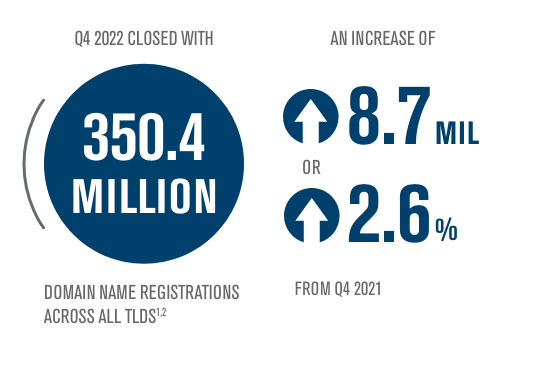
Check out the latest issue of The Domain Name Industry Brief to see domain name stats from the fourth quarter of 2022, including:
• Top 10 Largest TLDs by Number of Reported Domain Names
• Top 10 Largest ccTLDs by Number of Reported Domain Names
• ngTLDs as Percentage of Total TLDs
• Geographical ngTLDs as Percentage of Total Corresponding Geographical TLDs
To see past issues of The Domain Name Industry Brief, please visit https://verisign.com/dnibarchives.
The post Verisign Domain Name Industry Brief: 350.4 Million Domain Name Registrations in the Fourth Quarter of 2022 appeared first on Verisign Blog.




Image: Shutterstock.com
Three different cybercriminal groups claimed access to internal networks at communications giant T-Mobile in more than 100 separate incidents throughout 2022, new data suggests. In each case, the goal of the attackers was the same: Phish T-Mobile employees for access to internal company tools, and then convert that access into a cybercrime service that could be hired to divert any T-Mobile user’s text messages and phone calls to another device.
The conclusions above are based on an extensive analysis of Telegram chat logs from three distinct cybercrime groups or actors that have been identified by security researchers as particularly active in and effective at “SIM-swapping,” which involves temporarily seizing control over a target’s mobile phone number.
Countless websites and online services use SMS text messages for both password resets and multi-factor authentication. This means that stealing someone’s phone number often can let cybercriminals hijack the target’s entire digital life in short order — including access to any financial, email and social media accounts tied to that phone number.
All three SIM-swapping entities that were tracked for this story remain active in 2023, and they all conduct business in open channels on the instant messaging platform Telegram. KrebsOnSecurity is not naming those channels or groups here because they will simply migrate to more private servers if exposed publicly, and for now those servers remain a useful source of intelligence about their activities.
Each advertises their claimed access to T-Mobile systems in a similar way. At a minimum, every SIM-swapping opportunity is announced with a brief “Tmobile up!” or “Tmo up!” message to channel participants. Other information in the announcements includes the price for a single SIM-swap request, and the handle of the person who takes the payment and information about the targeted subscriber.
The information required from the customer of the SIM-swapping service includes the target’s phone number, and the serial number tied to the new SIM card that will be used to receive text messages and phone calls from the hijacked phone number.
Initially, the goal of this project was to count how many times each entity claimed access to T-Mobile throughout 2022, by cataloging the various “Tmo up!” posts from each day and working backwards from Dec. 31, 2022.
But by the time we got to claims made in the middle of May 2022, completing the rest of the year’s timeline seemed unnecessary. The tally shows that in the last seven-and-a-half months of 2022, these groups collectively made SIM-swapping claims against T-Mobile on 104 separate days — often with multiple groups claiming access on the same days.
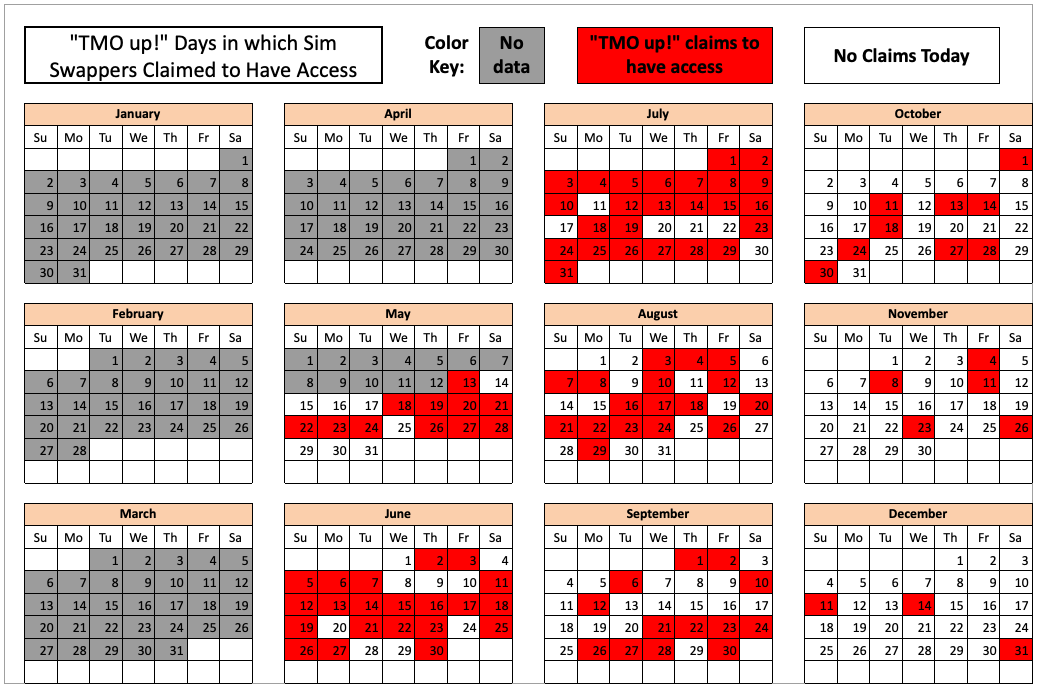
The 104 days in the latter half of 2022 in which different known SIM-swapping groups claimed access to T-Mobile employee tools.
KrebsOnSecurity shared a large amount of data gathered for this story with T-Mobile. The company declined to confirm or deny any of these claimed intrusions. But in a written statement, T-Mobile said this type of activity affects the entire wireless industry.
“And we are constantly working to fight against it,” the statement reads. “We have continued to drive enhancements that further protect against unauthorized access, including enhancing multi-factor authentication controls, hardening environments, limiting access to data, apps or services, and more. We are also focused on gathering threat intelligence data, like what you have shared, to help further strengthen these ongoing efforts.”
While it is true that each of these cybercriminal actors periodically offer SIM-swapping services for other mobile phone providers — including AT&T, Verizon and smaller carriers — those solicitations appear far less frequently in these group chats than T-Mobile swap offers. And when those offers do materialize, they are considerably more expensive.
The prices advertised for a SIM-swap against T-Mobile customers in the latter half of 2022 ranged between USD $1,000 and $1,500, while SIM-swaps offered against AT&T and Verizon customers often cost well more than twice that amount.

To be clear, KrebsOnSecurity is not aware of specific SIM-swapping incidents tied to any of these breach claims. However, the vast majority of advertisements for SIM-swapping claims against T-Mobile tracked in this story had two things in common that set them apart from random SIM-swapping ads on Telegram.
First, they included an offer to use a mutually trusted “middleman” or escrow provider for the transaction (to protect either party from getting scammed). More importantly, the cybercriminal handles that were posting ads for SIM-swapping opportunities from these groups generally did so on a daily or near-daily basis — often teasing their upcoming swap events in the hours before posting a “Tmo up!” message announcement.
In other words, if the crooks offering these SIM-swapping services were ripping off their customers or claiming to have access that they didn’t, this would be almost immediately obvious from the responses of the more seasoned and serious cybercriminals in the same chat channel.
There are plenty of people on Telegram claiming to have SIM-swap access at major telecommunications firms, but a great many such offers are simply four-figure scams, and any pretenders on this front are soon identified and banned (if not worse).
One of the groups that reliably posted “Tmo up!” messages to announce SIM-swap availability against T-Mobile customers also reliably posted “Tmo down!” follow-up messages announcing exactly when their claimed access to T-Mobile employee tools was discovered and revoked by the mobile giant.
A review of the timestamps associated with this group’s incessant “Tmo up” and “Tmo down” posts indicates that while their claimed access to employee tools usually lasted less than an hour, in some cases that access apparently went undiscovered for several hours or even days.
How could these SIM-swapping groups be gaining access to T-Mobile’s network as frequently as they claim? Peppered throughout the daily chit-chat on their Telegram channels are solicitations for people urgently needed to serve as “callers,” or those who can be hired to social engineer employees over the phone into navigating to a phishing website and entering their employee credentials.
Allison Nixon is chief research officer for the New York City-based cybersecurity firm Unit 221B. Nixon said these SIM-swapping groups will typically call employees on their mobile devices, pretend to be someone from the company’s IT department, and then try to get the person on the other end of the line to visit a phishing website that mimics the company’s employee login page.
Nixon argues that many people in the security community tend to discount the threat from voice phishing attacks as somehow “low tech” and “low probability” threats.
“I see it as not low-tech at all, because there are a lot of moving parts to phishing these days,” Nixon said. “You have the caller who has the employee on the line, and the person operating the phish kit who needs to spin it up and down fast enough so that it doesn’t get flagged by security companies. Then they have to get the employee on that phishing site and steal their credentials.”
In addition, she said, often there will be yet another co-conspirator whose job it is to use the stolen credentials and log into employee tools. That person may also need to figure out how to make their device pass “posture checks,” a form of device authentication that some companies use to verify that each login is coming only from employer-issued phones or laptops.
For aspiring criminals with little experience in scam calling, there are plenty of sample call transcripts available on these Telegram chat channels that walk one through how to impersonate an IT technician at the targeted company — and how to respond to pushback or skepticism from the employee. Here’s a snippet from one such tutorial that appeared recently in one of the SIM-swapping channels:
“Hello this is James calling from Metro IT department, how’s your day today?”
(yea im doing good, how r u)
i’m doing great, thank you for asking
i’m calling in regards to a ticket we got last week from you guys, saying you guys were having issues with the network connectivity which also interfered with [Microsoft] Edge, not letting you sign in or disconnecting you randomly. We haven’t received any updates to this ticket ever since it was created so that’s why I’m calling in just to see if there’s still an issue or not….”
The TMO UP data referenced above, combined with comments from the SIM-swappers themselves, indicate that while many of their claimed accesses to T-Mobile tools in the middle of 2022 lasted hours on end, both the frequency and duration of these events began to steadily decrease as the year wore on.

T-Mobile declined to discuss what it may have done to combat these apparent intrusions last year. However, one of the groups began to complain loudly in late October 2022 that T-Mobile must have been doing something that was causing their phished access to employee tools to die very soon after they obtained it.
One group even remarked that they suspected T-Mobile’s security team had begun monitoring their chats.
Indeed, the timestamps associated with one group’s TMO UP/TMO DOWN notices show that their claimed access was often limited to less than 15 minutes throughout November and December of 2022.
Whatever the reason, the calendar graphic above clearly shows that the frequency of claimed access to T-Mobile decreased significantly across all three SIM-swapping groups in the waning weeks of 2022.
T-Mobile US reported revenues of nearly $80 billion last year. It currently employs more than 71,000 people in the United States, any one of whom can be a target for these phishers.
T-Mobile declined to answer questions about what it may be doing to beef up employee authentication. But Nicholas Weaver, a researcher and lecturer at University of California, Berkeley’s International Computer Science Institute, said T-Mobile and all the major wireless providers should be requiring employees to use physical security keys for that second factor when logging into company resources.

A U2F device made by Yubikey.
“These breaches should not happen,” Weaver said. “Because T-Mobile should have long ago issued all employees security keys and switched to security keys for the second factor. And because security keys provably block this style of attack.”
The most commonly used security keys are inexpensive USB-based devices. A security key implements a form of multi-factor authentication known as Universal 2nd Factor (U2F), which allows the user to complete the login process simply by inserting the USB key and pressing a button on the device. The key works without the need for any special software drivers.
The allure of U2F devices for multi-factor authentication is that even if an employee who has enrolled a security key for authentication tries to log in at an impostor site, the company’s systems simply refuse to request the security key if the user isn’t on their employer’s legitimate website, and the login attempt fails. Thus, the second factor cannot be phished, either over the phone or Internet.
Nixon said one confounding aspect of SIM-swapping is that these criminal groups tend to recruit teenagers to do their dirty work.
“A huge reason this problem has been allowed to spiral out of control is because children play such a prominent role in this form of breach,” Nixon said.
Nixon said SIM-swapping groups often advertise low-level jobs on places like Roblox and Minecraft, online games that are extremely popular with young adolescent males.
“Statistically speaking, that kind of recruiting is going to produce a lot of people who are underage,” she said. “They recruit children because they’re naive, you can get more out of them, and they have legal protections that other people over 18 don’t have.”
For example, she said, even when underage SIM-swappers are arrested, the offenders tend to go right back to committing the same crimes as soon as they’re released.
In January 2023, T-Mobile disclosed that a “bad actor” stole records on roughly 37 million current customers, including their name, billing address, email, phone number, date of birth, and T-Mobile account number.
In August 2021, T-Mobile acknowledged that hackers made off with the names, dates of birth, Social Security numbers and driver’s license/ID information on more than 40 million current, former or prospective customers who applied for credit with the company. That breach came to light after a hacker began selling the records on a cybercrime forum.
In the shadow of such mega-breaches, any damage from the continuous attacks by these SIM-swapping groups can seem insignificant by comparison. But Nixon says it’s a mistake to dismiss SIM-swapping as a low volume problem.
“Logistically, you may only be able to get a few dozen or a hundred SIM-swaps in a day, but you can pick any customer you want across their entire customer base,” she said. “Just because a targeted account takeover is low volume doesn’t mean it’s low risk. These guys have crews that go and identify people who are high net worth individuals and who have a lot to lose.”
Nixon said another aspect of SIM-swapping that causes cybersecurity defenders to dismiss the threat from these groups is the perception that they are full of low-skilled “script kiddies,” a derisive term used to describe novice hackers who rely mainly on point-and-click hacking tools.
“They underestimate these actors and say this person isn’t technically sophisticated,” she said. “But if you’re rolling around in millions worth of stolen crypto currency, you can buy that sophistication. I know for a fact some of these compromises were at the hands of these ‘script kiddies,’ but they’re not ripping off other people’s scripts so much as hiring people to make scripts for them. And they don’t care what gets the job done, as long as they get to steal the money.”
A security firm has discovered that a six-year-old crafty botnet known as Mylobot appears to be powering a residential proxy service called BHProxies, which offers paying customers the ability to route their web traffic anonymously through compromised computers. Here’s a closer look at Mylobot, and a deep dive into who may be responsible for operating the BHProxies service.

The BHProxies website.
First identified in 2017 by the security firm Deep Instinct, Mylobot employs a number of fairly sophisticated methods to remain undetected on infected hosts, such as running exclusively in the computer’s temporary memory, and waiting 14 days before attempting to contact the botnet’s command and control servers.
Last year, researchers at Minerva Labs spotted the botnet being used to blast out sextortion scams. But according to a new report from BitSight, the Mylobot botnet’s main functionality has always been about transforming the infected system into a proxy.
The Mylobot malware includes more than 1,000 hard-coded and encrypted domain names, any one of which can be registered and used as control networks for the infected hosts. BitSight researchers found significant overlap in the Internet addresses used by those domains and a domain called BHproxies[.]com.
BHProxies sells access to “residential proxy” networks, which allow someone to rent a residential IP address to use as a relay for their Internet communications, providing anonymity and the advantage of being perceived as a residential user surfing the web. The service is currently advertising access to more than 150,000 devices globally.
“At this point, we cannot prove that BHProxies is linked to Mylobot, but we have a strong suspicion,” wrote BitSight’s Stanislas Arnoud.
To test their hypothesis, BitSight obtained 50 proxies from BHProxies. The researchers were able to use 48 of those 50 proxies to browse to a website they controlled — allowing them to record the true IP addresses of each proxy device.
“Among these 48 recovered residential proxies IP addresses, 28 (58.3%) of those were already present in our sinkhole systems, associated with the Mylobot malware family,” Arnoud continued. “This number is probably higher, but we don’t have a full visibility of the botnet. This gave us clear evidence that Mylobot infected computers are used by the BHProxies service.”
BitSight said it is currently seeing more than 50,000 unique Mylobot infected systems every day, and that India appears to be the most targeted country, followed by the United States, Indonesia and Iran.
“We believe we are only seeing part of the full botnet, which may lead to more than 150,000 infected computers as advertised by BHProxies’ operators,” Arnoud wrote.
The website BHProxies[.]com has been advertised for nearly a decade on the forum Black Hat World by the user BHProxies. BHProxies has authored 129 posts on Black Hat World since 2012, and their last post on the forum was in December 2022.
BHProxies initially was fairly active on Black Hat World between May and November 2012, after which it suddenly ceased all activity. The account didn’t resume posting on the forum until April 2014.
According to cyber intelligence firm Intel 471, the user BHProxies also used the handle “hassan_isabad_subar” and marketed various software tools, including “Subar’s free email creator” and “Subar’s free proxy scraper.”
Intel 471’s data shows that hassan_isabad_subar registered on the forum using the email address jesus.fn.christ@gmail.com. In a June 2012 private message exchange with a website developer on Black Hat World, hassan_isabad_subar confided that they were working at the time to develop two websites, including the now-defunct customscrabblejewelry.com.
DomainTools.com reports that customscrabblejewelry.com was registered in 2012 to a Teresa Shotliff in Chesterland, Ohio. A search on jesus.fn.christ@gmail.com at Constella Intelligence, a company that tracks compromised databases, shows this email address is tied to an account at the fundraising platform omaze.com, for a Brian Shotliff from Chesterland, Ohio.
Reached via LinkedIn, Mr. Shotliff said he sold his BHProxies account to another Black Hat World forum user from Egypt back in 2014. Shotliff shared an April 2014 password reset email from Black Hat World, which shows he forwarded the plaintext password to the email address legendboy2050@yahoo.com. He also shared a PayPal receipt and snippets of Facebook Messenger logs showing conversations in March 2014 with legendboy2050@yahoo.com.
Constella Intelligence confirmed that legendboy2050@yahoo.com was indeed another email address tied to the hassan_isabad_subar/BHProxies identity on Black Hat World. Constella also connects legendboy2050 to Facebook and Instagram accounts for one Abdala Tawfik from Cairo. This user’s Facebook page says Tawfik also uses the name Abdalla Khafagy.
Tawfik’s Instagram account says he is a former operations manager at the social media network TikTok, as well as a former director at Crypto.com.
Abdalla Khafagy’s LinkedIn profile says he was “global director of community” at Crypto.com for about a year ending in January 2022. Before that, the resume says he was operations manager of TikTok’s Middle East and North Africa region for approximately seven months ending in April 2020.
Khafagy’s LinkedIn profile says he is currently founder of LewkLabs, a Dubai-based “blockchain-powered, SocialFi content monetization platform” that last year reported funding of $3.26 million from private investors.
The only experience listed for Khafagy prior to the TikTok job is labeled “Marketing” at “Confidential,” from February 2014 to October 2019.
Reached via LinkedIn, Mr. Khafagy told KrebsOnSecurity that he had a Black Hat World account at some point, but that he didn’t recall ever having used an account by the name BHProxies or hassan_isabad_subar. Khafagy said he couldn’t remember the name of the account he had on the forum.
“I had an account that was simply hacked from me shortly after and I never bothered about it because it wasn’t mine in the first place,” he explained.
Khafagy declined to elaborate on the five-year stint in his resume marked “Confidential.” When asked directly whether he had ever been associated with the BHProxies service, Mr. Khafagy said no.
That Confidential job listing is interesting because its start date lines up with the creation of BHproxies[.]com. Archive.org indexed its first copy of BHProxies[.]com on Mar. 5, 2014, but historic DNS records show BHproxies[.]com first came online Feb. 25, 2014.
Shortly after that conversation with Mr. Khafagy, Mr. Shotliff shared a Facebook/Meta message he received that indicated Mr. Khafagy wanted him to support the claim that the BHProxies account had somehow gone missing.
“Hey mate, it’s been a long time. Hope you are doing well. Someone from Krebs on Security reached out to me about the account I got from you on BHW,” Khafagy’s Meta account wrote. “Didn’t we try to retrieve this account? I remember mentioning to you that it got stolen and I was never able to retrieve it.”
Mr. Shotliff said Khafagy’s sudden message this week was the first time he’d heard that claim.
“He bought the account,” Shotliff said. “He might have lost the account or had it stolen, but it’s not something I remember.”
If you liked this story, you may also enjoy these other investigations into botnet-based proxy services:
A Deep Dive Into the Residential Proxy Service ‘911’
911 Proxy Service Implodes After Disclosing Breach
Meet the Administrators of the RSOCKS Proxy Botnet
The Link Between AWM Proxy & the Glupteba Botnet
15-Year-Old Malware Proxy Network VIP72 Goes Dark
Who’s Behind the TDSS Botnet?
“Where do we start?”
This is the question every CISO asks about every new program. In fact, I ask and answer that question many times a month. There’s a reason for this, of course. A strong start to any project builds momentum, reassures stakeholders, and sets the stage for what’s to come. Security resilience initiatives are no different. Security resilience is the ability to anticipate and respond to unpredictable threats or changes, and then emerge stronger. It’s hard to imagine a more vital undertaking for CISOs. And as with all initiatives, CISOs always want to know where to begin.
They’re likely to find some valuable starting points in the Security Outcomes Report, Volume 3: Achieving Security Resilience, the latest in a series of reports released by Cisco and reflecting the viewpoints of 4,700 IT and security professionals from 26 countries. The report identifies seven success factors CISOs can pursue to improve outcomes within their own enterprise security resilience programs, placing a high priority on security resilience. The seven success factors range in nature from the architectural—simplifying your hybrid IT environment, maximizing zero trust adoption—to more relationship-focused factors.
It’s the latter that caught my eye.
Seven success factors for resilience:
It shouldn’t surprise any CISO that the first two success factors are built around relationships. These factors zero in on relationships with company leadership (as measured by establishing executive support) and relationships with people across the organization (as measured by cultivating a culture of security). Experienced CISOs know that these factors can make or break security initiatives.
Given the objective of security resilience is to withstand threats and come back even stronger, it’s clear that resilience must exist before, during, and after a cybersecurity incident. This has repercussions on the executive level and throughout the business. Lack of executive support can lead to detection, response, and recovery capabilities that are chronically underfunded. This leaves CISOs at a disadvantage when security incidents do inevitably happen and panic strikes the C-suite. What’s more, CISOs who lack strong executive relationships may also find themselves struggling to oversee incident management and coordinate communications. And afterward? Remediating and improving the security posture, which often impacts multiple parts of the organization beyond IT and often requires significant investment, stalls without a necessary lift from leadership.
The security report, which scores resilience levels across a series of criteria, finds that organizations reporting a strong backing from leadership have resilience scores that are 39% higher when compared to organizations reporting weak support. “Bridges to the C-suite are built upon a solid understanding of how the business works and how security initiatives can make it work even better,” notes the report. “Support goes both ways in any relationship, after all.”

In addition to keeping the program aligned, CISOs must keep in communication with their peers and superiors. Those who share only transactional relationships within the C-Suite find their interactions limited to status updates and budget requests. Transformational relationships, however, involve more frequent and deeper communication and interactions, which cover a broader set of topics than submitting the latest budget ask. They are, in other words, more valuable.
Of course, executive support is just one crucial factor for success. Resilience programs need broad support from throughout the organization, not just at the top. Every time an employee picks up a mouse or accesses an app from their mobile phone, they make a choice to either strengthen or lessen the organization’s security posture. Every time an improvement is necessary following a security event, cultural buy-in determines whether this new request from security is implemented or circumvented.
According to the report, organizations that successfully foster a culture of security can see a 46% increase in resilience compared to those who lack such a culture. Much like aligning a program with the business direction furthers leadership buy-in, CISOs need to align security policy with the functional direction of the business—but in a way that helps employees see security measures as protecting not just corporate data and IT assets but also their own future. When employees aren’t on board or see security measures as IT concerns with no relation to them, resilience suffers. “Frequent security policy violations and workarounds,” notes the report, “are evidence of poor security culture.” By viewing policy exceptions as feedback, and investigating these from the perspective of identifying and correcting misalignment, security leaders can enroll employees as the willing participants in the solution—rather than contributors to the problem.
Security leaders know, by and large, what we need to do to secure our organizations. We have frameworks with pages of controls. We have risk registers with lists of action items. Where we often struggle is translating this knowledge into action. To do that, we must see our efforts within the strategic context of executive leaders and the tactical reality of the line managers in our organization. We must personalize and prioritize our efforts around what matters to the people we collaborate with. It is through engaging people that our security programs become human-centric and, in turn, become more resilient.
Where do we start? With relationships. Good relationships lead to good security programs, and good security programs lead to great relationships. And all of these contribute to security resilience.
Download the Security Outcomes Report, Vol. 3: Achieving Security Resilience today.
Explore more original research and blogs like this:
We’d love to hear what you think. Ask a Question, Comment Below, and Stay Connected with Cisco Secure on social!
Cisco Secure Social Channels
The use of unmanaged and IoT devices in enterprises is growing exponentially, and will account for 55.7 billion connected devices by the end of 2025. A critical concern is deploying IoT devices without requisite security controls.
While these numbers are numbing, their reality is undeniable. 90% of customers believe digitization has accelerated the importance placed upon security. The World Economic Forum now lists cybersecurity failure as a critical threat, and estimates a gap of more than 3 million security experts worldwide, hindering secure deployments at scale. Furthermore, 83% of IoT-based transactions happen over plaintext channels and not SSL, making them especially risky.
Securing an IoT device can be achieved either through securing the IoT device itself, or hardening the network it accesses. Securing devices can be cumbersome, requiring complex manufacturing partnerships and increasing unit prices, thereby reducing adoption. On the other hand, securing the network is always desirable as it helps secure access, encrypt traffic, and ease management.
Being a leader in both security and networking, Cisco continues to bring security closer to networking, providing the network with built-in security, and enabling the network to act both as sensor and as an enforcer. The convergence of security and networking leverages the network’s intelligence and visibility to enable more-informed decisions on policy and threats.
Cisco uniquely integrates security and networking, for instance we recently integrated Cisco Secure Firewall to operate on Cisco Catalyst 9000 Series switches. Additionally, Secure Firewall can be deployed in a containerized form, on-premises and in clouds. Cisco Secure Firewall classifies traffic and protects applications while stopping exploitation of vulnerable systems. Additionally, we offer Identity Services Engine with AI Endpoint Analytics to passively identify IoT devices and apply segmentation policies. Furthermore, Cisco offers management flexibility by integrating with Cisco Defense Orchestrator and DNA Center and with existing customer tools like SIEMs and XDRs.
Let’s look at three use cases where the addition of Secure Firewall capability on Catalyst 9000 Series switches solves real world problems:
Use case 1: Securing the Smart Building: This solution is ideal to secure smart buildings, converging various IoT systems into a single IT-managed network infrastructure. Smart buildings lower the operational and energy costs. Smarter building systems, however, pose serious security risks as these include so many unmanaged devices such as window shades, lighting, tailored HVAC, and more. One of the methods to secure smart buildings is to control access to avoid manipulation of sensors. Such control is attained with a networking switch with enhanced firewall capability. The firewall ensures granular segmentation, directing policies for traffic generated out of IoT devices, providing access to the right users. This integration also brings security closer to endpoints, making policy orchestration simpler.
Use Case 2: Centrally manage isolated IoT network clusters: IoT devices which communicate with each other in the same subnet typically cannot be routed, which is a challenge. By default, most IoT networks are configured in the same subnet, making it difficult to manage them centrally. Administrators are forced to physically connect to the IoT network to manage and collect telemetry. Furthermore, IoT vendors often charge hefty amounts to update IP addresses of devices. Cisco Secure Firewall, hosted on the Catalyst switch, solves this problem and not only inspects traffic from the IoT network but also translates duplicate IoT IP addresses to unique global IP addresses using NAT for centralized management of isolated IoT networks.
Use Case 3: Securely encrypt IoT traffic passing through a shared IT network: At airports, for example, multiple vendors manage unique systems such as baggage, air quality, biometric access control, etc, which share a common network. IoT traffic is usually in plain text, making it susceptible to packet sniffing, eavesdropping, man-in-the-middle attacks, and other such exploits. The IPSec capability on Cisco Secure Firewall encrypts IoT traffic, securing data transfer and reducing risk.
Cisco’s IoT initiatives join the once disconnected worlds of IT and IoT, unifying networking and security. For further details refer to the At-A Glance and see how and an Australian oil company, Ampol, fortified its retail IoT with Cisco Secure!
We’d love to hear what you think. Ask a Question, Comment Below, and Stay Connected with Cisco Secure on social!
Cisco Secure Social Channels
Be impeccable with your words. It’s the first of the Four Agreements – a set of universal life principles outlined in the bestselling book by Don Miguel Ruiz. ‘Being impeccable with your words’ is my favorite, and it’s no surprise. As a product marketer, I spend most of my daily existence casting about for the perfect word to use in web copy, a webinar, or video script.
Words can connect us, as well as divide us. In helping to develop the message that Cisco takes to the market about zero trust, I try to be as impeccable as I can with each word. After all, cybersecurity is too important to be cavalier about what is possible – within a particular use case, product, or service.
Clarifying what zero trust means to you comes first. The zero trust principles reflect another of the four agreements: ‘Don’t make assumptions’. Don’t assume that a user or device is trusted based on their presence on the network, their type of device, or any other aspect of the connection request. Instead, verify it.
At the same time, don’t assume that everyone in your organization is in accord with, or clear on the goals of a zero trust initiative. Confirm goals and clearly communicate them. Over the past year, I’ve met with several customers keen to embark on zero trust and generally those goals involve one or more of the following:
The phrase zero trust does not inspire trust, clarity, or transparency. No name is perfect, but the challenge with calling an architecture that is consistent with a ‘never assume trust, always verify it, and enforce the principle of least-privilege’ policy ‘zero trust’ is that it sends the message that ‘one cannot ever be trusted’.
Changing the mindset of anyone is already a complex undertaking, but
starting off with a lack of trust (even if it’s only a word) doesn’t help.

Zero trust is simply good security. Zero trust is a conversation about the totality of the security stack, and how to bring it to bear in ways that allow teams to…
Simply put, make sure that one only has access to resources they need and that any violations of this policy are investigated.
Relationships build trust – an essential ingredient for zero trust momentum. In the Harvard Business Review’s “Begin with Trust”, Frances Frei and Anne Morriss describe three key drivers for trust: authenticity, logic, and empathy. Perhaps we can apply these drivers within the context of zero trust security:
We’d love to hear what you think. Ask a Question, Comment Below, and Stay Connected with Cisco Secure on social!
Cisco Secure Social Channels
In today’s security climate, NetOps and SecOps teams are witnessing increased attack surface area as applications and workloads move far beyond the boundaries of their data center. These applications/workloads move to, and reside in multi-cloud architecture, adding complexity to connectivity, visibility, and control. In the multi-cloud world, the SecOps teams use a distributed security model that is expensive, difficult to deploy, and complex to manage.
Cisco has partnered with Alkira to help secure your multi-cloud environment. Combining Alkira’s simplified cloud connection through their cloud network-as-a-service platform (SaaS-like model) with Cisco’s industry-leading security controls, we can deliver a centralized security model for multi-cloud architecture that is easy to deploy, manage, and increases visibility and control.
Cisco Secure Firewall Threat Defense Virtual provides unmatched security controls such as stateful firewalling, Snort3 IPS, URL filtering, malware defense, application visibility and control, and more. Additionally, with the purchase of Secure Firewall Threat Defense Virtual, you will receive license entitlement to Cisco SecureX, our open XDR and orchestration platform, helping you accelerate threat detection, investigation, and remediation.
Cisco Secure Firewall Management Center (FMC) is required for managing Secure Firewall Threat Defense Virtual, helping administrators enforce consistent access policies, rapidly troubleshoot security events, and view summarized reports across the deployment.
Secure Firewall Threat Defense Virtual is available on Alkira’s service marketplace through Bring-Your-Own-License (BYOL) and Pay-As-You-Go licensing options. Customers can seamlessly deploy and insert Secure Firewall in their Alkira Cloud Exchange Points (CXP).
Benefits of this integrated architecture include:
The Cisco Secure Firewall Threat Defense brings the following capabilities to the environment:
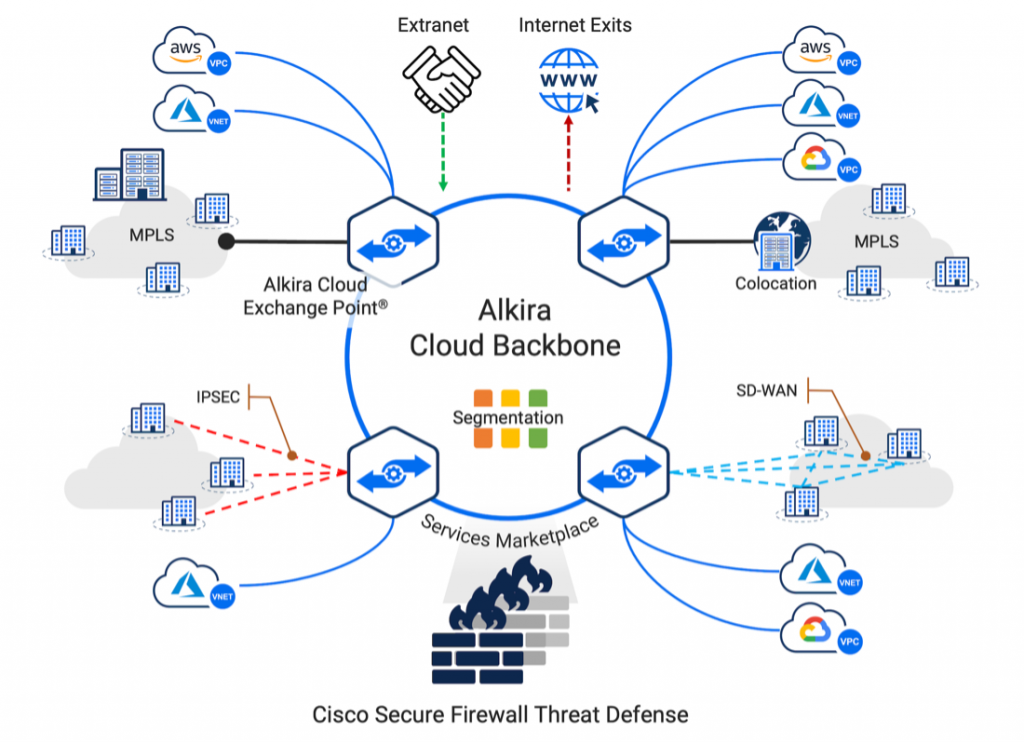
Figure 1 shows a multi-cloud environment inter-connected using Alkira Cloud Exhange Platform (CXP). In the above architecture, Cisco provides seamless insertion of security controls and enables the following use cases for firewall insertion:
Using Alkira’s customer portal, Cisco Secure Firewall Threat Defense Virtual can be easily inserted in the traffic path within minutes. Figure 2 shows how automation & orchestration eliminates additional configuration required in the legacy insertion model.

Cisco Secure Firewall Threat Defense Virtual is managed using Cisco Secure Firewall Management Center (FMC). Customers can use on-premises FMC or build a virtual FMC instance in the cloud. Cisco and Alkira support both models of deployment.
Cisco Secure Firewall Threat Defense Virtual protects the following traffic flows in Alkira CXP:
Alkira and Cisco’s partnership simplifies the deployment of enterprise-grade security in the cloud while enabling multi-cloud visibility and end-to-end threat defense for customers.
Additional Resources:
Cisco Secure Firewall Threat Defense
Cisco Secure Firewall Data Sheet
Cisco Secure Firewall Management Center
Alkira blog on Cisco Secure Firewall Threat Defense
We’d love to hear what you think. Ask a Question, Comment Below, and Stay Connected with Cisco Secure on social!
Cisco Secure Social Channels
For Cisco engineers working on Duo, having a remote-first workplace has helped them reach life goals, connect with colleagues around the world, and be intentional communicators. We understand that working remotely can be an adjustment — that’s why we’ve compiled the 10 parts of remote work that surprised our team members most and their advice for navigating the nuances. If you’re interested in being part of a remote-first workplace, check out our open positions.
Senior Engineering Leader David Rines has worked remotely for the past seven years. He’s found that Cisco’s approach to distributed teams has “enabled us to pick up the right talent, and not necessarily local talent. We are moving towards a global, follow the sun environment,” he said.
One of the aspects Rines appreciates most of this structure is getting “a widely varied set of perspectives and experiences that help build a more reliable, more robust product, which is why we’re here.”

Another benefit to having colleagues across the globe is the sharing of recipes, a perk Senior Site Reliability Engineer Bernard Ting particularly enjoys. Proactively communicating with colleagues virtually “helps you to form bonds with people from other teams. You can always learn something new about cultures elsewhere. I talk to people about food and so I’m always gathering recipes from people from all over the world,” Ting shared.
While some may fear that working remotely could lead to feelings of isolation and loneliness, a different camaraderie can flourish in the structure of our distributed teams. With colleagues across time zones, “there’s always someone there who you can reach out to help solve your problem,” Rines said.
Collaboration hours are another way Site Reliability Engineering Manager Jaya Sistla has cultivated virtual community and problem-solving. These hours are blocked off for team members to talk about what they’re working on. “The main thing is being able to ask for help so you don’t go into the rabbit hole debugging things,” Sistla said.
Ting points out that working in a distributed model allows you to really engage in virtual events and conversations. Given that the team mainly communicates through online chat, Ting has found that “forces you to see everyone as equally approachable, which has made me more comfortable reaching out to people from anywhere in the world.”
For folks sharing an office, collaboration can happen through casual chats over coffee. When facing a challenge, you can ask your neighbor for support. While ideally virtual communication could have a similar cadence and spontaneity, the logistics of remote and distributed work require intentionality and being proactive in connecting with colleagues as people and as co-workers.
When Ting first started working remotely, he felt that every meeting needed to be formal and have a business objective. By sharing his feelings with his manager, he was reassured that “socializing is a very important part of teamwork, because if you don’t have a good relationship with your colleagues you’re not going to be able to have healthy discussions, healthy conflict or be able to critique each other when the situation arises.”
Since that conversation, Ting has been more proactive about catching up with colleagues, which can include sharing a coffee over video chat. Duo’s “coffee roulette” formalizes the process as every month, employees who opt in can be randomly paired up for a quick half-hour chat focused exclusively on socializing. Ting has found being proactive about socializing virtually helpful. “It’s made me more intentional with my time and really treasure the social experience you can get,” he said.
Some folks may be concerned that without a manager observing their efforts and work ethic day in and day out, it may be harder to recognize accomplishments and challenges. Ting found that within his team “when you work on projects and in your one-on-ones with your managers, they’re always very intentional about learning what you’ve been doing and seeing what your progress is like on certain projects. I’ve been asked, ‘How do you think you can improve? What are some of the things you’ve been doing outside of the team work?’”

To cultivate cross-team collaboration and education, there are thoughtfully planned virtual lunch and learns. “We schedule training sessions and common meetings at times that are flexible for everyone. If it has to be repeated, we do it so people can comfortably attend rather than stretching themselves and attending at odd hours,” Sistla said.
For Software Engineer Nick Aspinall, an important and fun part of working remotely is keeping in touch with virtual messaging. One unique perk has been getting to create and customize emojis with team members including a few of himself in “various ridiculous states,” he said.
Connecting with colleagues on themed channels focused on personal and professional interests from coffee to pets “makes it really cool because you can meet people across different teams and still get some of the feeling of rubbing elbows that you get when you’re in the office,” Aspinall said. Participating in these virtual conversations boosts morale while also providing an endless supply of cute animal pics.
Given the multi-faceted nature of our work and the importance of consistent information sharing, having different communication channels and formats to communicate data with varying degrees of complexity is vital. Having information readily accessible, accurate and updated is particularly necessary in a field like cybersecurity.
Senior Software Engineer Mario Lopez finds that the variety of information sources contributes to an easeful remote working experience. For instance, for complex architecture decisions or detailing, Duo’s Wiki is the best source.
Software Engineer Hanna Fernandez has benefited from chat channels dedicated to design and engineering topics to “see what everyone’s up to and what thoughts people have,” she said. Sista pointed out these are great places to ask questions and open up dialogue to solve problems.
Our culture is “video-on,” meaning that it is preferred that during video meetings, as much as possible, attendees have their cameras on. Lopez loves this because “you get a bit of that personal human element.”
“We’re all people behind these screens. You definitely get some of people’s personality through text, but you get it more when you actually see them. It’s infectious when you see someone smiling. You’ve got to smile back,” he shared (while we both smiled).
When Fernandez started at Cisco, she was advised to schedule individual meetings with everyone she would be working with on every team that she joined. That suggestion is one she’s applied even virtually.

“It’s a great strategy because I already know that my team is super talented and very smart, but this way I also get to know them as humans beyond their roles,” Fernandez said. Fernandez also finds it important to check in with co-workers and ask how they’re feeling and how their time off was. “I know a lot of people hate small talk, but it’s not just small talk. I’m genuinely interested in how my co-workers are doing.”
One of Ting’s biggest goals was buying his first house in the countryside outside of London. By working remotely, Ting has flexibility in his location which allowed him to achieve his goal of buying a house and settling down with his partner, while giving their dogs the space they need to be dogs.

When transitioning from fully remote to hybrid, it’s important to recognize that there will be some shifts to get accustomed to. As the structures of remote, distributed and hybrid work evolve, it’s important to stay flexible and notice what’s possible through multiple modalities of team building. Many teams have enjoyed in-person gatherings and connecting through virtual lunches and team games when remote.
Fernandez has had multiple roles with multiple structures at Cisco. As an intern, she was fully in person and shared desk space with other interns who collaborated on full stack engineering. While working in finance IT, Fernandez was hybrid and many of her colleagues were distributed among multiple offices. The pandemic began while she was in a DevOps role, forcing her to maintain boundaries around her work time while working fully remotely. In her current role working on Duo, Fernandez is completely remote but advocates for in-person events if possible, because “humans are social creatures who want to see each other’s faces in real life once in a while.”
For Aspinall, “when we did come back to the office, there was a bit of an adjustment period where you were overstimulated from the office.” He also wanted to ensure team members who were 100% remote were fully included. Now he sees that while half his team is fully remote and the other half is hybrid, “that doesn’t stop anyone from doing anything. All of our meetings feel the same. They’re all seamless.”
If you’re interested in joining our team from wherever you are in the world, check out our open roles.
We’d love to hear what you think. Ask a Question, Comment Below, and Stay Connected with Cisco Secure on social!
Cisco Secure Social Channels